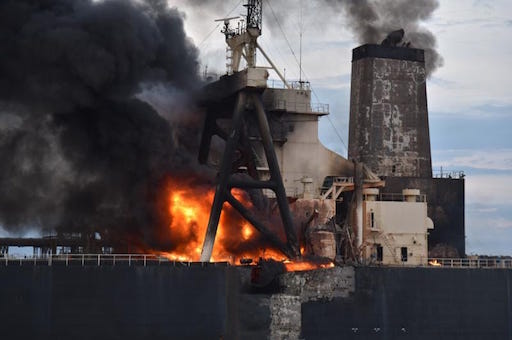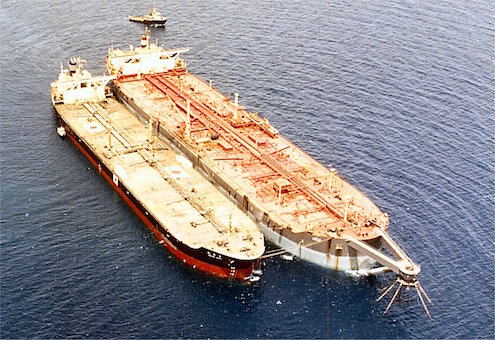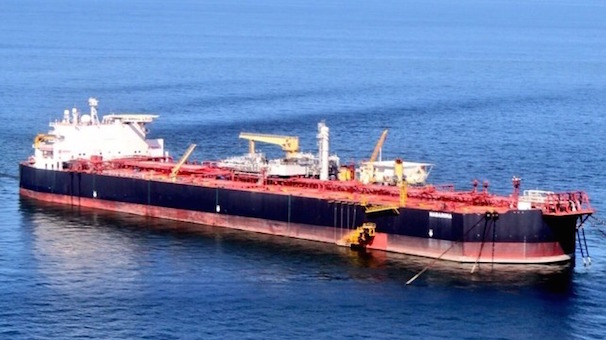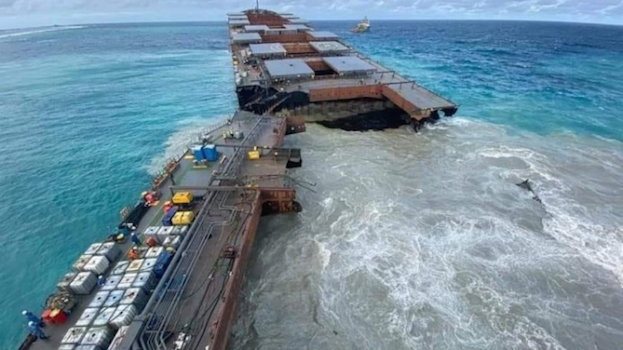While the French Navy is sealing up cracks on the forepart of the Tanio wreck (1980) off Brittany, oil spills or oil spill risks are multiplying. The Covid-19 pandemic is involved in this resurgence. The crews are no longer relieved. Confined to their workplaces, they are overworked, cut off from the world and depressed. The Indian captain of the Wakashio, which ran aground on Mauritius, had been on board for a year and other crew members for 9 months. The minimal maintenance of merchant ships is also delayed. Political circumstances are other aggravating factors, as in the example of FSO (Floating Storage and Offloading) units which in peacetime “feed” tankers that have come empty from all over the world.
New Diamond, Sri Lanka, Bay of Bengal, Indian Ocean
 New Diamond. Photo Indian Coast Guard
New Diamond. Photo Indian Coast Guard
Europe is a stakeholder. The shipowner New Shipping Ltd-Lib is Greek. It is a subsidiary of the Polembros family-owned group. They are both domiciled at 57a Poseidon(os) Avenue in Piraeus. The 333 m long and 60 m wide monster transports 270,000 tons of crude oil. The New Diamond came from Kuwait and was heading for Paradip, Odisha State (India).
She has been on fire since 3 September off the east coast of Sri Lanka. A boiler exploded in the engine room and killed a Filipino mechanic. The fire devoured the entire stern of the tanker. A flotilla of the Sri Lankan and Indian navies, 2 Russian navy units, tugs and other fire-fighting vessels escorted and watered the wreck. The New Diamond was then about 70 km off the coast. The management staff, 5 Greeks, and the surviving stokers, 23 Filipinos, were evacuated ashore.
On 6 September, after being pulled out to sea by a Sri Lankan tugboat taking advantage of calm seas, she was 75 km off the coast.
On September 7, the wreck, driven by headwinds, came back 60 km off the coast. After a deceptive retreat and a premature announcement on its extinction, the fire resumed on 7 September and got closer to the crude oil tanks. It seems to be contained again but the game is not over yet. Smouldering fires are treacherous. A crack tears the hull at the level of the engines. Part of the propulsion fuel spilled into the sea along with the residual extinguishing waters.
Today, 10 September, the spokesman for the Sri Lankan Navy reiterated that the smoke and flames on and around the New Diamond are no longer visible or perceptible. A team of three experts boarded the ship to confirm this diagnosis. The New Diamond has a 1 km long plume of fuel in her wake. She continues to be towed offshore and is about 76 km away from the coast. A global oil spill would be catastrophic for the Bay of Bengal and its coastal States, first and foremost Sri Lanka and India. Bangladesh, Burma, Thailand and the northwestern islands of Indonesia could also be threatened.
Rescuers do not show a positive safety strategy. They continue to keep the tanker away from the coast, a common reflex in this kind of crisis. The doctrine of place of refuge where the wrecked oil tanker could in the best possible conditions be lightened does not seem to be a priority. The passing the buck syndrome has struck again. According to the ISM (International Safety Management) code for the Safe Operation of Ships at sea, the Greek shipowner must be in the front line of the rescue operation. He commissioned Smit Salvage Singapore to evaluate the various options and support the New Diamond with high-powered tugs, one of which has just left Mauritius, where she towed the bow of the Wakashio for her to be scuttled 8 miles off the coast (see below).
When it comes to getting rid of its tankers and bulk carriers, the Greek shipowner New Shipping Ltd-Lib is very reactive and sends them alternatively for scrapping in Pakistan or Bangladesh depending on the availability of the yards and the variations in scrap metal prices.
Sri Lanka’s Exclusive Economic Zone is crossed by the maritime highway linking the Middle East, India, China, Japan and other Asian countries. Sri Lanka does not have the equivalent of a Polmar plan (Marine Pollution response plan). Knowing that, according to a tweet from the President of the French Republic two weeks after the Wakashio ran aground in Mauritius, “action is urgently needed when biodiversity is in danger”, it is urgent for France to get closer to Sri Lanka in order to give it the benefit of the experience it has accumulated since the grounding and sinking of the Amoco Cadiz in 1978 (227,000 tonnes). Sea cucumbers, sea turtles, marine mammals, sharks and other protected species off the coast of Sri Lanka are under permanent threat from oil spills or oil discharges. Also at stake is the protection of traditional fishing activities and the defence of coastal populations from crude oil produced in the Middle East and destined for India breaking and entering into their territory.
Safer, Yemen, Red Sea

Oil transshipment from the Safer (right) to the Tokiwa Maru, April 21,1988.
Auke Visser Collection.
Robin des Bois (Robin Hood) mentioned the Safer risk (ex-Esso Japan) in “Shipbreaking” # 59 (pdf) published in May 2020. This 44 year old ex-Very Large Crude Carrier was converted in 1987 into an FSO (Floating Storage and Offloading unit). Her last official owner since 1986 was Yemen Exploration Co Ltd based in Dallas (Texas, USA). She was operated off the Yemeni Ras Isa terminal until the Houthist rebellion took control of the area in March 2015. The Safer has since remained without any maintenance with an estimated cargo of 1.14 million barrels of light crude oil (150,000 tonnes) in her tanks. The NGO Conflict and Environment Observatory sounded the alarm. Since 2018, she has been raising the concerns of the international community. Her state of corrosion, the explosive vapours that accumulate in the tanks, the general dilapidated condition and the loss of outdated equipment at sea, are all factors of early warning. The Red Sea is exposed to a dramatic oil spill. The Ras Isa terminal is located next to the island of Kamaran, whose mangroves, coral reefs and exceptional aquatic biodiversity make it a natural candidate for the list of protected marine areas in the Red Sea and the Gulf of Aden. In July 2019, the Houthist rebels denied access to the Safer by experts appointed by the United Nations (UN) who were tasked with establishing a precise diagnosis and a safety protocol. After the explosion of ammonium nitrate in the port of Beirut on August 4, 2020, international concerns about the unpredictable situation of the Safer, her structural vulnerability and her exposure to terrorist risks have increased. A flurry of diplomatic activity is stirring around the old oil tanker who should have been phased out and scrapped one or two decades ago.
“IMO is proactively working on contingency planning, it is hoped that international efforts will succeed in paving the way to assessing the state of the FSO and taking necessary measures, in order to prevent an oil spill from occurring”, said Patricia Charlebois, Deputy Director, Subdivision for Implementation of International Conventions at IMO including the Marpol Convention for the Prevention of Pollution from Ships, in mid-August. “In the case of oil spills, prevention is always better than cure. However, should these efforts fail, we want to ensure adequate preparedness measures are in place” she added. In other words, the IMO wants anti-pollution resources to be pre-positioned in this politically and environmentally sensitive area to deal as effectively as possible with a massive crude oil spill.
Nabarima, Venezuela, Caribbean Sea
 Nabarima
Nabarima
The Nabarima is an FSO unit owned by Petróleos de Venezuela SA (PDVSA). She is 264 m long and 52 m wide, built in 2005, and has no motorization. Since 2015, she has been permanently anchored in the Corocoro offshore oil field in the Gulf of Paria shared between Venezuela and the archipelago of Trinidad and Tobago. The Nabarima is operated by the Venezuelan State company jointly with the Italian company ENI (Ente Nazionale Idrocarburi). At the end of August 2020, Eudis Girot, head of the FUTPV (Federación Unitaria de Trabajadores del Petróleo del Venezuela) sounded the alarm. The FSO is in an alarming state. A ballast tank is pierced and water has flooded the technical compartments to a height of 1.50 m. The FUTPV is questioning the onboard maintenance carried out, according to it, by an incompetent workforce. The Nabarima has lost the use of her pumps and developed a slight list. She has also lost her electrical autonomy. 173,000 tonnes of crude oil have been stored on board for more than a year.
The most favourable option would be to lighten the Nabarima on the spot. But the Venezuelan FSO is also being held hostage to US policy and the US embargo on Venezuela’s oil sector that has been in place since 2017. The intervention of international companies likely to organise the transhipment of the hazardous cargo, the use of foreign-flagged shuttle tankers and the export sale of the cargo are in conflict with President Trump’s decisions. On 6 September, the Trinidad & Tobago-based NGO Fishermen and Friends of the Sea called for help from the European Union and the Italian government to try to unblock the situation.
Venezuela and Trinidad & Tobago are bound by a bilateral agreement to implement an oil spill contingency plan. It would be inoperative in case the Nabarima would sink. In this eventuality, the Gulf of Paria, which also hosts extraordinary fauna and fishing activities, would be condemned and the waters of the Caribbean Sea, Surinam, Guyana, French Guyana and northern Brazil would also be exposed to the threat.
See also about the oil spill off the coast of Brazil from August 2019 “The Anonymous Oil Spill”, 19 December 2019 (only in French “La marée noire anonyme“).
Wakashio, Mauritius, Indian Ocean
 Wakashio. Photo Le Mauricien
Wakashio. Photo Le Mauricien
The iron ore shuttle service between Brazil and China is a nightmare. Loaded with 260,000 tonnes of ore and 3,000 tonnes of bunker fuel, the Stellar Daisy sank in the South Atlantic in 2017. 22 sailors perished at sea. In June 2020, the Stellar Banner was scuttled by the Brazilian Navy after she ran aground on a sandbank just outside the port of Ponta da Madeira after lightening her cargo and pumping out most of her fuel oil.
On 25 July 2020, Mauritius was hit in turn. The grounding of the Wakashio, sailing empty of ore to Brazil from the Chinese port of Lianyungang, but full of bunker fuel, caused the devastation of a protected area, a 400-hectare coral garden inhabitated by sponges and sea cucumbers, bordered by mangroves. At least 1000 tons of fuel oil were spilled at sea. Even the butterflies are at half mast. The crew of the Wakashio was evacuated unharmed at the beginning of the crisis, but the shipwreck left 3 people dead and one missing on 1 September, when the small tug Sir Gaetan sank after being hit by the barge of fuel oil residues she was towing back to Port Louis. Three days before the sinking of the Sir Gaetan, at least 40 melon-headed whales washed up on the beaches in the lagoon damaged by the Wakashio.
This is not the first time that Mauritius has been the scene of maritime accidents. In August 2011, the Panamanian bulk carrier Angel 1 ran aground on the reefs of Poudre d’Or with her cargo of 30,000 tonnes of rice and 900 tonnes of bunker fuel. The vessel was refloated and partially emptied of her cargo and fuel and was then scuttled offshore. In July 2013, the container ship Hansa Brandenburg, victim of a fire during her journey from Singapore to Durban, found refuge in Port Louis. The Hansa Brandenburg was towed for demolition in Pakistan 6 months later, the fate of the burnt cargo and the polluted extinguishing waters is not known. In June 2016, the Liberian-flagged bulk carrier Benita ran aground on the beach of Bouchon in the south of the island after a fight among the multinational crew of Filipino and Taiwanese sailors. 400 to 500 tonnes of bunker fuel oil leaked from the cracked tanks and soiled the lagoon, rocks, mangroves, fishing grounds and lobster pots. On month later, the ship was freed by the Greek maritime salvage company Five Oceans Salvage which was also responsible for delivering the Benita to Alang scrapyards in India. The cracks of the bulk carrier’s hull were patched up in a hurry. She was weakened and never reached her final destination: 6 days after starting her last voyage, she sinks 175 km off the coast of Mauritius.
After the Benita disaster in 2016, voices were raised in Mauritius calling for the implementation of an oil spill prevention plan and the setting up of an intervention team. The call has not really prompted effective action. The Fisheries Minister hastened to declare on 26 July 2020: “This is the first time we have been confronted with a disaster like this and we are not sufficiently equipped to deal with this problem”. On 29 August, a protest march in Port Louis gathered thousands of demonstrators who denounced the disaster management and the lack of responsiveness by the Mauritian government. 200 km away from Mauritius, Reunion Island is exposed to the same threats. France and Mauritius would be well advised to become definitively aware of the risks that maritime traffic and giant cargo ships carrying dangerous materials pose to the marine environment and the local economy. The two countries should pool their legal and diplomatic resources and develop their technical means to lock up sea pirates.
 Imprimer cet article
Imprimer cet article








